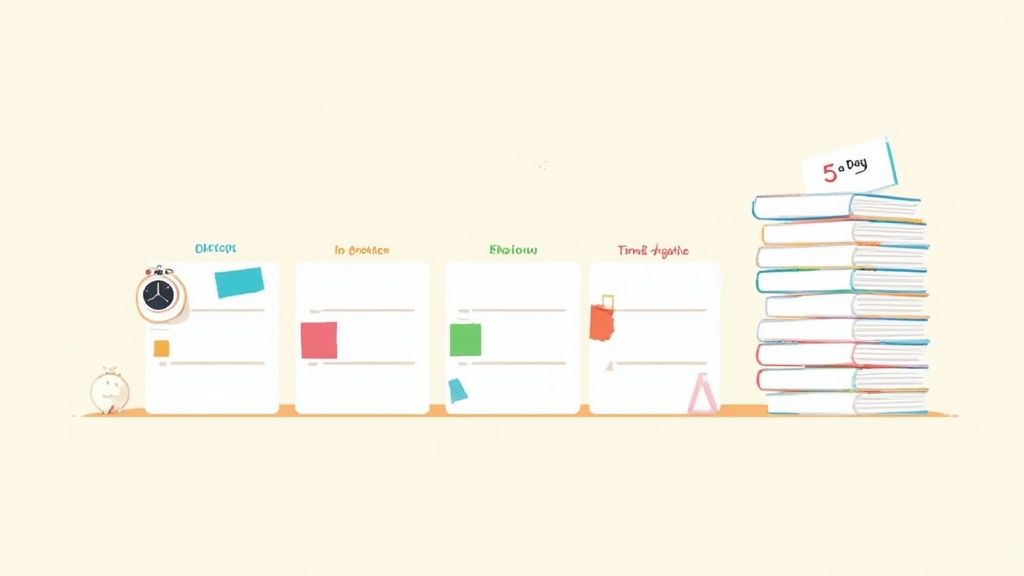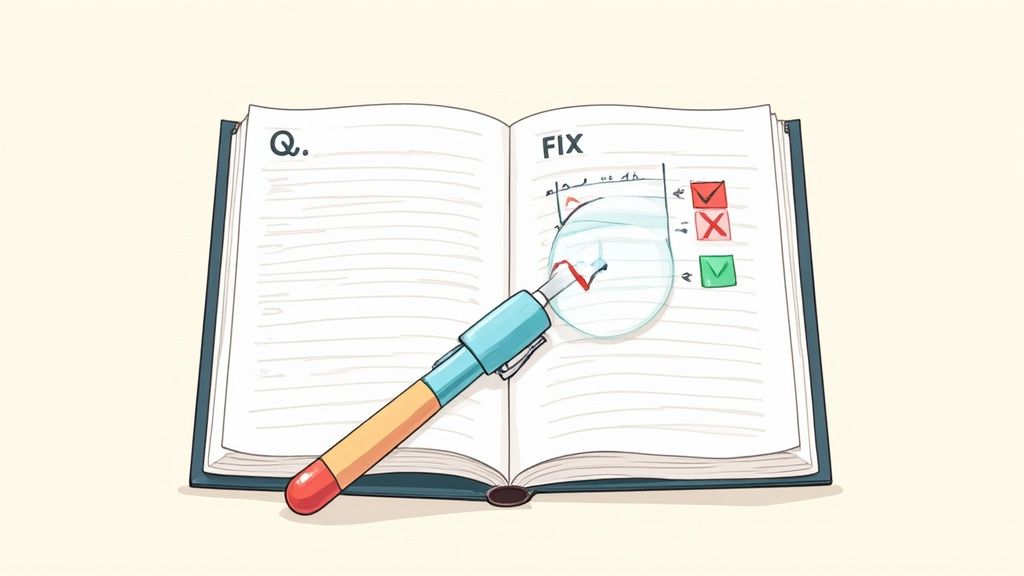How to Study for SAT Math and Raise Your Score
A proven guide on how to study for SAT Math. Learn smart practice routines, error analysis techniques, and test-day strategies to boost your score.

Before you even think about cracking open a textbook or drilling endless practice problems, you need a starting point. The single most effective way to kick off your SAT Math prep is to figure out exactly where you stand right now.
Think of it this way: you wouldn't start a road trip without looking at a map first. Just guessing at your weak spots is a recipe for wasted time and frustration. You need real data to build a smart, targeted study plan that actually works.
Diagnosing Your SAT Math Strengths and Weaknesses
First things first, you need to take a full, official SAT Math practice test. And I mean a real simulation. Don't do it on the couch while half-watching TV. Find a quiet spot, set a timer for the No-Calculator and Calculator sections, and treat it like the real deal. This isn't just about getting a score; it's about feeling the pressure of the clock so you can see how you perform under test-day conditions.
Creating Your Performance Blueprint
Once the timer goes off and you've scored your test, the real work begins. Your score is just a number. The gold is in your mistakes. This is where you put on your detective hat and analyze every single question you missed or even just guessed on.
I recommend creating a simple error log—a spreadsheet or even a notebook works perfectly. For every question that gave you trouble, jot down two critical pieces of information:
- The Topic: What was the question actually testing? Was it Heart of Algebra? Problem Solving and Data Analysis? Passport to Advanced Math? Or was it one of the "Additional Topics" like geometry or trig? The College Board helpfully categorizes every question, so this part is easy.
- The "Why": This is where you have to be brutally honest. Did you just flub the calculation? Did you completely misread what the question was asking? Or did you look at it and have absolutely no idea which formula or concept to use?
This process is like finding a treasure map. You'll quickly see patterns emerge. Maybe you’re an algebra whiz but every geometry question trips you up. Or perhaps you realize you're losing a ton of points to simple, careless mistakes when you're rushing.
A huge mistake I see students make is ignoring the questions they guessed on but got right. That's just luck. Treat those "lucky guesses" as wrong answers, because they expose a knowledge gap that could easily burn you on the actual test.
This diagnostic step isn't just about getting a baseline; it's the bedrock of your entire study strategy. And it’s more important than ever. A fascinating 2024 analysis looking at SAT Math tests from 2008 to 2023 revealed something surprising: even though the questions got a bit easier over time, students' scores actually dropped by an average of 37 points.
What does that tell us? It shows that just hoping for easier questions won't cut it. You need a focused strategy to buck that trend. You can dig into the full study on long-term SAT performance trends yourself, but the takeaway is clear: your personalized diagnostic is the first and most critical step toward mastering this test.
Building a Rock-Solid Conceptual Foundation
Think of your diagnostic test results as a blueprint. They show you exactly where the cracks are in your SAT Math knowledge. Now, it's time to roll up your sleeves and start the real work. This phase isn't about mindlessly cranking through problems; it's about methodically building a deep, unshakable understanding of the core concepts that the entire exam is built on.
Rote memorization will only get you so far. True confidence comes from knowing why a formula works, not just what it is. The goal is to go from "I think I remember this from sophomore year" to "I can solve this type of problem in my sleep."
Navigating the Core Content Areas
The SAT Math test isn’t just a random assortment of questions. It’s strategically designed to test your skills across four main categories. The smart way to study is to mirror this structure, focusing your energy where it’ll make the biggest difference.
Here’s a breakdown of the content you’ll face:
- Heart of Algebra: This is the big one, making up about 33% of the questions. It's all about linear equations, systems of linear equations, and linear functions. If your diagnostic showed weakness here, your top priority should be mastering how to create, solve, and interpret these expressions.
- Problem Solving and Data Analysis: Accounting for roughly 29% of the exam, this area is all about rates, ratios, percentages, and proportions. You'll also see a lot of questions that require you to interpret data from tables, graphs, and charts. Think of these as "real-world" math problems.
- Passport to Advanced Math: This section makes up around 28% of the test and dives into more complex algebra. We're talking about manipulating quadratic equations, working with exponential functions, and understanding tricky function notation. For anyone aiming for a top-tier score, acing this section is non-negotiable. Some questions might even dip into topics like logarithms, so knowing https://feen.ai/blog/how-to-solve-logarithmic-equations can give you a serious advantage.
- Additional Topics in Math: This is the smallest category at about 10%. It covers a mix of topics, mostly geometry, basic trigonometry (SOHCAHTOA), and complex numbers. While it’s a smaller piece of the pie, these are often quick points to grab if you know the fundamental rules.
To help you organize your study plan, here's a quick reference table.
SAT Math Core Content Areas and Study Priorities
This table breaks down the main domains tested on the SAT Math section. Use it to align your study priorities with the areas that have the most impact on your score.
| Content Domain | % of Test (Approx.) | Key Topics to Master |
|---|---|---|
| Heart of Algebra | 33% | Linear equations & inequalities, systems of two linear equations, linear function graphing & interpretation. |
| Problem Solving & Data Analysis | 29% | Ratios, rates, proportions, percentages, unit conversions, scatterplots, data collection & conclusions. |
| Passport to Advanced Math | 28% | Quadratic equations, exponential functions, function notation, manipulating polynomials, isolating quantities. |
| Additional Topics in Math | 10% | Geometry (lines, angles, triangles, circles), basic trigonometry (SOHCAHTOA), complex numbers. |
Seeing the content laid out like this makes it clear: a higher score comes from a targeted plan, not just random practice.

This visual really drives home the point that prep is a cycle—you assess, you learn with focus, and you plan your next move.
Ditch the Memorization—Embrace Active Learning
Just rereading a textbook chapter on quadratics is a surefire way to forget everything in a week. To truly lock in these concepts, you have to get your hands dirty. That means actively working through example problems step-by-step, explaining concepts out loud (even if it's just to yourself), and creating your own "master sheet" of formulas and concepts.
To get better at this, check out some effective note-taking examples that show you how to organize complex math ideas in a way that actually sticks.
Key Insight: Don't just write down formulas. For every single one, add notes on what it does, when to use it, and a simple example. Next to the quadratic formula, you might jot down: "Use this to find the x-intercepts of a parabola when factoring is too messy or impossible." That context is the glue that makes the knowledge stick under pressure.
Formulas: What's Given vs. What You Must Know
One of the first questions I always get from students is, "Which formulas do I have to memorize?" The College Board provides a small reference sheet at the start of each math section, but if you have to flip back to it for every other question, you're going to run out of time. Fast.
Here's the deal:
Formulas Provided on the SAT:
- Area and circumference of a circle
- Area of a rectangle and triangle
- Volume formulas for a box, cylinder, sphere, cone, and pyramid
- The Pythagorean theorem
- Special right triangle rules (30-60-90 and 45-45-90)
Formulas You Should Absolutely Have Memorized:
- Slope-intercept form: y = mx + b
- Slope formula: (y₂ - y₁) / (x₂ - x₁)
- Midpoint formula: ((x₁+x₂)/2, (y₁+y₂)/2)
- Distance formula: √((x₂ - x₁)² + (y₂ - y₁)² )
- Quadratic formula: x = [-b ± √(b² - 4ac)] / 2a
- Vertex form of a parabola: y = a(x - h)² + k
- SOHCAHTOA: Sine = Opposite/Hypotenuse, Cosine = Adjacent/Hypotenuse, Tangent = Opposite/Adjacent
Committing these to memory is non-negotiable. They show up so often that having to look them up is a huge time-waster. The goal is instant recall—you see a problem and immediately know which tool to grab from your mental toolbox. This frees up precious brainpower to focus on the actual problem-solving, which is how you get to the next level.
Implementing a Smart and Consistent Practice Routine
Once you've got a handle on the core concepts, it's time to shift gears. Knowing the material is one thing; applying it with speed and accuracy under pressure is a whole different ballgame. This is where your study plan really comes to life. A smart, consistent practice routine is what turns that theoretical knowledge into real points on test day.
The goal here isn't to burn out. It's to build a sustainable rhythm that steadily hones your skills without leaving you feeling overwhelmed. The secret is a balanced weekly schedule that mixes focused, untimed practice on your weak spots with timed drills that get you used to the ticking clock. To make any of this stick, it’s crucial to learn how to focus effectively while studying, which means minimizing distractions and setting up your space for success.

Building Your Weekly Study Schedule
A solid weekly routine ensures you’re covering all your bases without getting bogged down in one area. The trick is to be intentional. Every time you sit down to study, you should know exactly what you’re trying to accomplish.
Here’s a sample framework you can steal and tweak to fit your own schedule:
- Monday & Wednesday (Deep Dives): Spend 45-60 minutes drilling down on a specific topic. Pull from your diagnostic results and pick a weak area—maybe it's quadratic functions or circle theorems. Work through problems untimed. The focus is 100% on accuracy and understanding, not speed.
- Tuesday & Thursday (Timed Drills): This is where you build your test-day muscle. Set a timer for 20-30 minutes and knock out a practice set. You can find these short quizzes in official prep books or online. The goal is to get comfortable making quick, confident decisions under pressure.
- Friday (Word Problem Focus): Give word problems their own dedicated session. For many students, these are the trickiest questions on the test, so they deserve special attention.
- Saturday (Review or Practice Test): Every other Saturday, take a full, timed Math section. On the weeks in between, use this time to go through your error log and truly understand the mistakes you've been making.
- Sunday (Rest): Seriously, take a break. Your brain needs downtime to consolidate everything you've learned.
Think of this as a starting point. The most important ingredient is consistency. Three focused hours spread throughout the week will always beat a six-hour cram session on Sunday.
Why Official Materials Are Gold
When it comes to practice, not all resources are created equal. You need to be using official materials from the College Board as your primary tool. Why? Because they write the test.
Using official SAT practice tests and questions from the College Board's Question Bank ensures you are practicing with the exact style, difficulty, and phrasing you will encounter on test day. Third-party materials can be great for drilling specific concepts, but they can sometimes miss the subtle nuances of how the SAT asks questions.
It's like training for a marathon. You wouldn't prepare by running exclusively on a treadmill if the race is on a hilly outdoor course. You have to train on the real thing to build familiarity and confidence.
The 5-a-Day Method for Word Problems
Let's be honest: word problems can be a major hurdle. They don't just test your math skills; they test your ability to translate a chunk of text into a clean mathematical equation. This is a skill that only gets better with dedicated practice.
That’s where my "5-a-Day" method comes in. It’s incredibly simple but wildly effective:
- Commit to five SAT word problems every single day. No excuses. They don't even have to be from the same topic.
- Read the actual question first. Before you get lost in the details, jump to the end and figure out what they’re asking for. This gives you a target.
- Underline key info and variables. As you read the full problem, actively mark up the numbers, relationships ("twice as many as"), and constraints.
- Translate English into math. "Is" means equals. "Of" means multiply. "Percent" means divide by 100. Get the equation on paper before you even think about solving it.
- Do a quick "sanity check." Does your answer make sense in the context of the problem? If the question asks for the number of buses needed and you get 7.4, you've probably made a calculation error. This final check catches a surprising number of mistakes.
Committing to this small daily habit will pay huge dividends, dramatically improving how quickly and confidently you can tear these problems apart. The data backs this up—structured SAT prep that includes timed practice and daily drills is proven to boost scores. Students who adopt these focused strategies have seen their scores jump by 100 points or more.
Turning Your Mistakes Into Points with Error Analysis
Just grinding through practice test after practice test is one of the most common—and flawed—ways to prep for the SAT. Real score improvements don't come from the quantity of problems you do, but from the quality of your review. This is where error analysis comes in, and frankly, it's the secret weapon that separates good scores from great ones.
Think of it this way: every wrong answer is a clue. It’s a bright, flashing arrow pointing directly to a gap in your knowledge or a flaw in your test-taking strategy. By methodically dissecting every single mistake, you stop the frustrating cycle of repeating the same errors and start turning them into guaranteed points on test day.

Create a Powerful Error Log
The best way to put error analysis into practice is with an error log. This isn't just a running list of questions you got wrong; it's your personal diagnostic tool. You can set this up in a simple spreadsheet or even a dedicated notebook, but getting the structure right is what matters most.
For every single question you miss—and even the ones you guessed on and got lucky—you need to play detective. Don't just mark it wrong and move on. Dig in and figure out the root cause.
Deconstructing the "Why" Behind Each Mistake
To get real value from your log, you have to categorize the reason for each mistake. This is the single most important step because it reveals the hidden patterns that are holding your score back. After a few practice tests, you’ll start to see exactly which types of errors are costing you the most points.
Most mistakes fall into one of these buckets:
- Conceptual Error: You just didn't know the math. You looked at the question and had no clue where to even start. This is a clear signal to go back to your notes or a resource like Khan Academy and rebuild your understanding of that specific topic from the ground up.
- Calculation Error: This one is always frustrating. You knew the formula, you followed the right steps, but a simple arithmetic slip-up—like a sign error or a misplaced decimal—led you to the wrong answer. These often happen when you're rushing.
- Reading Error: You totally misunderstood what the question was asking. Maybe you solved for x when it asked for 2x, or you breezed past a critical word like "not" or "integer." This is about slowing down just enough to process the details.
- Time Management Error: You knew exactly how to solve it, but the clock ran out. This points to a pacing problem that needs to be addressed with targeted, timed practice drills.
Be brutally honest with yourself here. It's tempting to brush off every mistake as "careless," but that's a trap. If you consistently make "careless" calculation errors on exponent problems, the real issue might be that your understanding of exponent rules isn't as solid as you think.
Building Your Error Log Template
A structured log is an organized one. Keeping your entries consistent makes it much easier to spot those all-important patterns. Below is a simple but incredibly effective template to get you started.
An error log gives you a systematic way to track and understand where you're going wrong.
Error Log Template for SAT Math
| Question # | Topic | My Answer | Correct Answer | Reason for Error (e.g., Calculation, Concept, Reading) | How to Solve Correctly |
|---|---|---|---|---|---|
| Section 4, #12 | Quadratics | 4 | -2 | Calculation Error | I correctly used the quadratic formula but made a sign error when simplifying the numerator. |
| Section 3, #8 | Geometry | 12π | 24π | Reading Error | The problem gave the radius, but I used it as the diameter when calculating the circumference. |
| Section 4, #25 | Data Analysis | C | A | Concept Error | I didn't understand how to correctly interpret "line of best fit" in the context of the scatterplot. |
Filling out this log consistently makes the review process an active one, not a passive one.
This process forces you to engage with the correct solution on a much deeper level. When you write out "How to Solve Correctly" in your own words, you're essentially teaching the concept back to yourself—one of the most powerful ways to make it stick for good.
This shift in mindset, from seeing errors as failures to seeing them as opportunities, is everything. It's how you build a resilient, analytical approach to your prep. You’re not just studying for a test; you're building a more robust understanding of the math itself.
Mastering Pacing and Test Day Strategies
All the hard work you’ve put into mastering concepts and analyzing errors boils down to this: your performance on test day. Knowing the math is only half the battle. The other half is executing a solid strategy under the pressure of the clock.
This is where smart pacing and test-taking habits become your secret weapon, turning all that knowledge into the high score you're aiming for.
Pacing isn't about rushing; it’s about being in control. It's about knowing exactly how to spend your precious minutes across the No-Calculator and Calculator sections to rack up the most points. The SAT Math questions are intentionally ordered from easiest to hardest, which is a huge strategic advantage if you know how to use it.
The Art of Triaging Questions
Your first pass through any section should be about one thing: grabbing all the low-hanging fruit. The last thing you want is to get bogged down on a tricky problem early on. Instead, you need to think like an emergency room doctor and triage every single question you see.
Here's a simple system I've seen work wonders:
- Easy (Green Light): You read it and immediately know how to solve it. Perfect. Do it right away and move on. These are your bread-and-butter points.
- Medium (Yellow Light): You're pretty sure you know how to solve it, but it looks like it might take a few steps or some careful thinking. Mark it and come back after you've scooped up all the easy ones.
- Hard (Red Light): You read it and have absolutely no idea where to even begin. This is a classic time sink. Circle it, skip it without a second thought, and only come back if you have time left at the very end.
This method ensures you never run out of time before attempting the questions you have the best shot at getting right. Wasting five minutes on a single hard question at the expense of five easy ones is a rookie mistake you can't afford to make.
My Personal Tip: Don't be afraid to skip aggressively. Your goal isn't to answer questions in order; it's to score as many points as possible. A confident skip is just as strategic as a correct answer.
When to Guess and When to Skip
This is a simple one. Since the SAT has no penalty for wrong answers, you should never leave a multiple-choice question blank. Ever. Even if you have to make a complete shot-in-the-dark guess in the final seconds, fill in a bubble.
Of course, a smart guess is always better than a blind one. The process of elimination is your best friend here. For most questions, you can almost always spot one or two answer choices that are logically impossible. Crossing them out dramatically improves your odds. For example, if a question asks for a positive integer and one of the choices is negative, get rid of it immediately.
This ties into a bigger picture about your prep timeline. Research analyzing over 150,000 student scores shows a clear link between when a student takes the SAT and their future success in college math. Students who test earlier, like in the fall of their junior year, often show a higher probability of earning top grades in college math than those who wait. You can explore the data on how test timing relates to college math success yourself. It really highlights why mastering these strategies well before senior year is such a powerful move.
Handling Grid-In Questions and Final Prep
Grid-in questions, or "student-produced responses," demand a little extra care. With no answer choices to guide you, small calculation errors can be much more costly.
Always double-check your bubbling here. Be extra careful with decimals and fractions. If an answer can be written as either 3/4 or .75, both are correct, but I've found that .75 is often faster and safer to bubble in correctly under pressure.
The week before the test is not the time to cram new material. It's all about getting your head in the right space and doing some light review.
- Stop New Learning: A few days before the exam, put a lid on trying to learn new concepts.
- Light Review: Casually go over your error log, focusing on the types of mistakes you tend to make.
- Prepare Your Bag: Get your calculator (with fresh batteries!), pencils, ID, and admission ticket ready the night before.
- Rest Up: A good night's sleep is far more valuable than a few extra hours of frantic studying.
Ultimately, confidence on test day is built on the foundation of preparation you've already laid. Just like with math problems, having a structured plan can make a daunting task feel manageable. If you're also gearing up for other parts of the exam, you might find our guide on how to write an essay fast helpful for time management.
Walk into that test center knowing you have a plan. Trust your prep, manage the clock, and go execute your strategy.
Answering Your Top SAT Math Questions
As you start piecing together your study plan, it's natural for questions to bubble up. Let's walk through some of the most common things students wonder about so you can move forward with a clear head and a solid strategy.
How Long Should I Actually Study for This Thing?
There's no magic number here, but we can definitely work with some solid estimates. If you're looking for a respectable score bump of around 50 points, you should probably budget about 10-20 hours of focused study time.
But what if you're aiming for a major score increase—say, 150 points or more? That's a different level of commitment. Be prepared to invest 80-100+ hours to make that kind of leap.
What this really means is that you need a consistent schedule. A student trying to get from a 550 to a 650 might study 3-5 hours a week for a couple of months. But if that same student wants to break into the 750+ elite, they'll need a much more rigorous plan spread over 4-6 months. The main takeaway? Consistency always beats cramming.
Should I Get a Tutor or Can I Do This on My Own?
This really comes down to how you learn best and how disciplined you are. Self-study is totally possible, especially if you're a self-starter who can take a hard look at your practice tests and figure out where you're going wrong. There are tons of fantastic free resources out there to help you on this path.
On the other hand, a good tutor can be a game-changer. If you find yourself hitting a wall on certain topics, struggling to stay on track, or just need someone to hold you accountable, a tutor's expertise is invaluable. They've seen it all and can often spot those subtle, repeating mistakes you might be missing on your own, giving you personalized fixes to speed up your progress.
What's the Single Biggest Mistake I Should Avoid?
Easy. The biggest trap students fall into is what I call passive practice. This is when you just churn through hundreds of practice problems without ever stopping to truly understand your mistakes. It's a common cycle: take a test, get a score you don't like, feel frustrated, and immediately dive into another one hoping for a different outcome.
This approach is a huge waste of your time. Real improvement comes from active, intentional review.
The most valuable part of your entire study routine is the time you spend dissecting your errors. You have to get to the bottom of why you made a mistake and then rework that problem until the correct path feels automatic. Your error log isn't just a side activity; it's the heart of your study system.
If I'm Not Sure, Should I Just Guess?
Yes, you absolutely should. The modern SAT has no penalty for guessing, so there is zero reason to ever leave a multiple-choice question blank. Always, always make an educated guess.
Think about the odds. If you can confidently rule out just one wrong answer, your chances of getting it right jump from 25% to 33%. Eliminate two, and you're suddenly at a 50/50 shot. For the grid-in questions, there's no penalty either, but a completely blind guess is a waste of time. If you can make a reasonable estimate, go for it, but don't get bogged down.
For more study strategies and deep dives into other academic subjects, feel free to explore the other guides on our Feen AI blog.
When you’re staring at a problem that feels impossible, get instant clarity with Feen AI. Just snap a photo of the question, and our AI homework helper will give you a clear, step-by-step walkthrough. Stop getting stuck and start making progress—give it a try for free at https://feen.ai.
Recent articles
Discover the empirical formula for ascorbic acid (C₃H₄O₃) with this clear, step-by-step guide. We break down the chemistry behind Vitamin C's simplest ratio.
Get our comprehensive physics formulas cheat sheet. A printable, easy-to-use guide with key equations, examples, and definitions for exam success.
Discover the best good transition words for conclusions to elevate your essays. Our guide offers examples, tips, and templates to make your writing stand out.
How to write a literary analysis essay: Learn to craft a strong thesis, support with evidence, and perform close reading for a compelling argument.
How to write a good essay introduction: learn proven techniques to hook readers, set context, and craft a strong thesis
Discover how to solve systems of linear equations with clear steps, example problems, and practical tips to boost your confidence.





